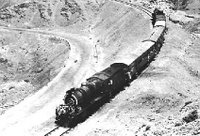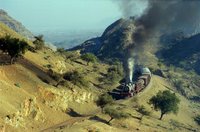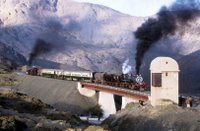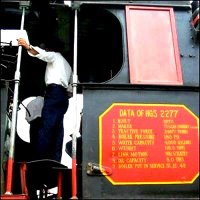Few days ago
ATP asked our readers to take a guess on number of Railway Stations in Pakistan. As far as my own personal research shows, the correct number is 1009 (possibly a few more) and my compilation of the complete index of stations is given below.
Some readers did guess the correct range, but as we had expected, most underestimated the number. I might have done so myself had I not already done the research. The list of stations is interesting to view, if only because you would read so many place names that you might never have heard of. I hope it will also make us think about the wonder that was the railway system in Pakistan at one time, but is no more.
The list below includes the stations that are currently operative as well as those which are now closed. We believe this list is still not exhaustive. There was atleast one railway section which connected Bahawalpur (Baghdad station) directly to Fort Abbas. This section was uprooted in the 1940s when during the World War II British needed steel. I am definitely missing the names of stations that were located on that section. If our readers know of any station that we missed, then let us know and we’ll update our records.
Before we go the list on next section, I want to feature the photo above by Tahir Iqbal of a small and now-closed Railway Station near Gujranwala called Theri Sansi. Pakistan has got hundreds of such small railway stations. With every passing day, unfortunately more and more of them are getting closed as Railways as means of transport in Pakistan is on a continuous decline.
The following list is current as of November 11, 2010
1. Abad
2. Abbasnagar (not operational)
3. Abbaspur (not operational)
4. Abdul Hakim
5. Abdullahabad (Halt)
6. Abdullahpur Kolar
7. Ab-I-Gum
8. Adamsahaba
9. Adamwahan
10. Ahmadpur
11. Ahmedwal
12. Ahsanpur
13. Air Force (Halt) (not operational)
14. Airport (Halt) (not operational)
15. Ajnala
16. Akhtar Karnana
17. Akhtarabad (old name Dhuniwala)
18. Akora Khattak
19. Ala
20. Alam Reg
21. Alamgir Town (Halt)
22. Aldana
23. Alhar
24. Alipur Chatha (old name Akalgarh)
25. Alipur Sayadan Sharif (old name Alipur Sayadan)
26. Allahdadani
27. Allahdino Sand
28. Alluwali
29. Amirpur (Halt)
30. Ammu Siding Beleli
31. Amri
32. Amruka
33. Arain Road
34. Arif Wala
35. Ashraf Shah
36. Asrani (not operational)
37. Athilpur
38. Attock City Jn (old name Cambellpur)
39. Attock Khurd (old name Attock)
40. Azad
41. Azmatwala
42. Babakwal
43. Babar Kachh
44. Babari Banda
45. Badah
46. Badal Nala
47. Badami Bagh
48. Baddomalhi
49. Badin
50. Badli Mazari
51. Bagatora
52. Baghdad
53. Bagiari (not operational)
54. Bahalike
55. Bahawalnagar Jn
56. Bahawalpur
57. Bahram Hathiyun
58. Bahrianwala (not operational)
59. Bahuman (not operational)
60. Bakhsh Jatoi (Halt)
61. Bakhshan Khan
62. Bakhshapur
63. Bakhtiarabad Domki (old name Bell-pat)
64. Bakrala
65. Bakrani Road
66. Baldher
67. Baldia (not operational – located on Karachi Circular Railway)
68. Balishah
69. Balochabad
70. Bandhi
71. Bandial
72. Banh Mianwala
73. Banni Bangla
74. Bannu (old name Edwardsabad) (not operational)
75. Barocho Bagh (not operational)
76. Baruli
77. Basal Jn
78. Basal Sharif (Halt)
79. Basirpur
80. Basti Darwesh Lashari
81. Basti Fauja
82. Basti Qutab Shah
83. Basti Rehman
84. Begmanji
85. Begowala Ghartal
86. Behal
87. Behkari (not operational)
88. Beleli
89. Bero Chandia (not operational)
90. Bhakkar
91. Bhalwal
92. Bhan Sayadabad
93. Bhaun (not operational)
94. Bhera
95. Bhila Hithar
96. Bhiria Road
97. Bhitshah (not operational)
98. Bhoe Asal
99. Bholari
100. Bhumb
101. Bhurgari (not operational)
102. Bijar (Halt)
103. Bijrani (old name Unarwah)
104. Bin Qasim Pipri
105. Bobi Road (not operational)
106. Border Post 72
107. Bostan Afghanan
108. Bostan Jn
109. Braudabad
110. Bubak Road
111. Buch
112. Bucheri
113. Buchiana
114. Budapur
115. Budh
116. Budho
117. Burhan
118. Burj
119. Cadet College Kohat
120. Cadet College Petaro (old name Petaro)
121. Chabiana
122. Chachar
123. Chachran (not operational)
124. Chagai
125. Chah Noor Mohammad
126. Chak
127. Chak Abdullah
128. Chak Amru
129. Chak Asmatullah (Halt) (not operational)
130. Chak Ibrahim Bhatti
131. Chak Jhumra Jn
132. Chak Kambo
133. Chak Lala
134. Chak Naurang (Halt) (not operational)
135. Chak Nizam (not operational)
136. Chak Pirana
137. Chak Saida (Halt)
138. Chak Sher Mohammad
139. Chak Turan
140. Chak Wariachanwala
141. Chakwal (not operational)
142. Chalisa Jn
143. Chaman
144. Chandrami (Halt) (not operational)
145. Chanesar (Halt)
146. Chang
147. Changa Manga
148. Chanigot
149. Charnali
150. Charsadda (not operational)
151. Chauntra
152. Chaweka Road
153. Chawinda
154. Chenab West Bank
155. Chet Singhwala (not operational)
156. Chhab
157. Chhor
158. Chichawatni Road
159. Chichoki Mallian
160. Chidarzai (not operational)
161. Chikarkot (not operational)
162. Chilianwala
163. Chiniot
164. Chishtian
165. Choa Kariala
166. Chukhra (Halt) (not operational)
167. Chund
168. Chura Sharif (Halt)
169. Chutiana
170. D.C.O.S (Halt) (not operational)
171. Dabanwala
172. Dabheji
173. Dad Fatihana
174. Dadu
175. Daera Dinpanah
176. Daera Mehram
177. Daharki
178. Dalbandin
179. Damboli
180. Dandot
181. Darbar Sahib Kartarpur
182. Darbelo (not operational)
183. Darkhana
184. Darsmand (not operational)
185. Dar-ul-Ihsan (old name Salar Wala)
186. Darya Khan
187. Daud (Halt)
188. Daud Khel Jn
189. Daulatala (not operational)
190. Daulatpur Safan (not operational)
191. Daur
192. Deona Juliani
193.Deparja
194. Departure Yard
195. Depot Hill Jn (not operational – Karachi Circular Railway)
196. Dera Allahyar (old name Jhatpat)
197. Dera Azim Khan (Halt) (not operational)
198. Dera Bakha (not operational)
199. Dera Ghazi Khan
200. Dera Murad Jamali (old name Temple Dera)
201. Dera Nawab Sahib
202. Dera Taj
203. Detha
204. Dhab Sanateka (not operational)
205. Dhak
206. Dhandi (not operational)
207. Dharowal Kang (Halt)
208. Dhaunkal
209. Dher Umed Ali
210. Dholan
211. Dhoro Naro
212. Dhrema (not operational)
213. Dhudial (not operational)
214. Digri
215. Dilmurad
216. Dina
217. Dinga
218. Dingra
219. Doaba (not operational)
220. Domala (old name Manjoke)
221. Domel (old name Pind Sultani Road)
222. Domeli
223. Dorata
224. Dozan
225. Drigh Colony Jn
226. Drigh Road Jn
227. Dunga Bunga (not operational)
228. Dunyapur
229. Durgai (not operational) (used to be the last station on Mardan-Dargai line)
230. Eminabad
231. Faisalabad (old name Lyallpur)
232. Faisalabad Dry Port
233. Faqir Hussain Shaheed (old name Nak Band) (not operational)
234. Faqirabad (old name Lawrencepur)
235. Faqirwali (not operational)
236. Farooqabad (old name Chuharkana)
237. Farooqia (Halt) (old name Hattar)
238. Fateh Jang
239. Fateh Shahpur (Halt)
240. Fazal Bhambro
241. Fazilpur Dhandi (not operational)
242. Firoza
243. Fort Abbas (not operational)
244. Gaddar
245. Gagan
246. Gaggoo
247. Gajargola
248. Galangur
249. Gambat
250. Gambila Serai (not operational)
251. Ganda Singhwala (not operational)
252. Garhi Khairo
253. Gat (Halt) (b/w Yakmach and Azad stations on Dalbandin-Koh-I-Taftan section) (not operational)
254. Gatti
255. Ghakka Mittar (not operational)
256. Ghakkar Mandi
257. Gharibwal
258. Ghotki
259. Ghulamabad (Halt) (not operational)
260. Ghungrila
261. Gidu (not operational) (located on the banks of River Indus at Kotri)
262. Gilani (not operational) (Karachi Circular Railway – was supposed to be Karachi’s Central Train Terminal in one of the Master plans of the city)
263. Gilawala
264. Gilmala (Halt)
265. Girdhariwala (not operational)
266. Gojra
267. Golpur
268. Golpur Talbani
269. Golra Sharif Jn (old name Golra Jn)
270. Gopang
271. Gosarji
272. Goth Shah Mohammad (not operational)
273. Gujar (old name Sody)
274. Gujar Garhi (not operational)
275. Gujar Khan
276. Gujranwala
277. Gujranwala Cant (old name Rahwali)
278. Gujranwala City (old name Gujranwala Town)
279. Gujrat
280. Gul Beg Marri (not operational)
281. Gul Imam (not operational)
282. Gul Sher
283. Gulistan
284. Gunna Kalan
285. Gurmani
286. Habib Kot Jn
287. Habibabad (old name Wan Radharam)
288. Hadali
289. Hafizabad
290. Haibat Shahid
291. Haider Jatoi (Halt)
292. Haji Chand
293. Hala (not operational)
294. Halani (not operational)
295. Halloki (Halt)
296. Hamdaniwala
297. Hangu (not operational) (Narrow gauge)
298. Haranpur
299. Harappa (old name Harappa Road)
300. Harbanspura
301. Hariah
302. Haripur Band
303. Haripur Hazara
304. Harnai
305. Harnal (Halt) (not operational)
306. Harunabad (not operational)
307. Haryanwala
308. Hasan Rind (not operational)
309. Hasilpur
310. Hasisar
311. Hassan Abdal
312. Hathiyan (not operational)
313. Haveli Wasawewala (old name Wasawewala)
314. Havelian
315. Hayat Sher Pao Shaheed
316. Hazrat Karmanwala (not operational)
317. Hazurpur
318. Hiral
319. Hirok
320. Humayun
321. Husri (not operational)
322. Hyderabad Jn
323. Injra
324. Iqbal Nagar
325. Isa Khel (not operational)
326. Jacobabad Jn
327. Jafarwala (not operational)
328. Jahangira Road
329. Jahania
330. Jajja Abbassian (not operational)
331. Jalal Marri
332. Jallo
333. Jallo Park (Halt)
334. Jalu-Jo-Chaunro (not operational)
335. Jam Sahib (not operational)
336. Jaman Shah
337. Jamke Chatta
338. Jampur
339. Jamraniwah
340. Jamrao Jn
341. Jamrud
342. Jan Muhammadwala
343. Jand Jn
344. Jangal Mariala
345. Janiwala
346. Jarala
347. Jaranwala
348. Jassar Jn
349. Jatoi (not operational)
350. Jauharabad
351. Jaurah Karnana
352. Jetha Bhutta
353. Jhakka Ladhana (on now closed Faisalabad-Jaranwala section) (not operational)
354. Jhalar
355. Jhamat
356. Jhang City
357. Jhang Sadar
358. Jhelum
359. Jhimpir
360. Jhok Ditta
361. Jhol (not operational)
362. Jhudo
363. Jhuluri
364. Jumma Goth
365. Jungshahi
366. Kabul River (not operational)
367. Kacha Khuh
368. Kachelo
369. Kachlak
370. Kahal (not operational)
371. Kahi (not operational)
372. Kahror Pakka
373. Kala Gujran (old name Kala)
374. Kala Khatai
375. Kala Shah Ka Ku
376. Kalabagh (not operational)
377. Kalanchwala
378. Kalas Goraya (Halt)
379. Kaleke
380. Kalhora (not operational)
381. Kaliamawan
382. Kallur Kot
383. Kalpani (not operational)
384. Kaluwal
385. Kamalia
386. Kamar Mashani (not operational)
387. Kamaro Sharif (not operational)
388. Kambar Ali Khan
389. Kamoke
390. Kan Mehtarzai (not operational) (used to be the highest narrow gauge station in South Asia before its closure in 1985)
391. Kana Kacha
392. Kanak (Halt)
393. Kandhkot
394. Kandiaro (not operational)
395. Kandwal (Halt)
396. Kanganpur
397. Kanjur
398. Kanjwani
399. Zorgarh
400. Karachi Cant
401. Karachi City
402. Karachi Unviersity (not operational) (Karachi Circular Railway)
403. Karor
404. Karsaz (Halt) (not operational)
405. Karyal (Halt) (not operational)
406. Kashmor
407. Kashmor Colony
408. Kassowal
409. Kasur Jn
410. Kata Kushta (not operational)
411. Kathala
412. Kazi Ahmed (not operational)
413. Khadro
414. Khairabad Kund
415. Khairpur
416. Khan (not operational)
417. Khanai (not operational)
418. Khanewal Jn
419. Khanora
420. Khanot
421. Khanpur Jn
42 2. Khanqah Mohamed Panah (not operational)
423. Khanqah Sirajia
424. Kharian
425. Kharian Cant
426. Khatan (not operational)
427. Khathar
428. Khatian
429. Khatian Road
430. Khatlani Shaheed (Halt) (not operational)
431. Khattakabad
432. Khewra
433. Khichiwala (not operational)
434. Khokhropar
435. Khost
436. Khudabad
437. Khudian Khas
438. Khuman (not operational)
439. Khunda Ladheke
440. Khushab
441. Khushal Kot
442. Kiamari East Wharf
443. Kiamari West Wharf
444. Kila Dewa Singh
445. Kila Saifulla (not operational) (narrow gauge)
446. Killa Abdullah
447. Killa Sobha Singh
448. Kinjheji (not operational)
449. Kirdagap
450. Kiridhor (not operational)
451. Kishingi
452. Kissan
453. Kohat Cant
454. Kohat Tehsil (not operational)
455. Koh-I-Noor
456. Kolpur
457. Korangi (not operational) (spur on Karachi Circular Railway)
458. Kot Abadan (Halt)
459. Kot Abbas Shaheed (old name Kot Mela Ram)
460. Kot Adu Jn
461. Kot Behram
462. Kot Chutta
463. Kot Darya Bal
464. Kot Daya Kishan (not operational)
465. Kot Ghulam Mohammad (old name Jamesabad) (not operational)
466. Kot Gurdit Singh (not operational)
467. Kot Haji Shah
468. Kot Ihsan (not operational)
469. Kot Khair Din (Halt)
470. Kot Lakhpat
471. Kot Lalloo
472. Kot Mul Chand
473. Kot Najib Ullah
474. Kot Nasir
475. Kot Nawaz (on now closed Faisalabad-Jaranwala section) (not operational)
476. Kot Pir Abdul Aziz (Halt)
477. Kot Radha Kishan
478. Kot Salim Shaheed (old name Kot Nihal Singh) (not operational)
479. Kot Sultan
480. Kotla Adib Shaheed
481. Kotla Jam
482. Kotla Pathan (not operational)
483. Kotri Jn
484. Kotsamaba
485. Kuchlak
486. Kuh-I-taftan
487. Kul Mokal
488. Kulab (not operational)
489. Kundian Jn
490. Kunri
491. Kunri Memon (Halt) (not operational)
492. Kussam Sar (not operational)
493. Kutabpur
494. Kut-al-Imara (not operational)
495. Kutbal (not operational)
496. Lahore Cant
497. Lahore Jn
498. Lakha Road
499. Lakhi Ghulam Shah (Halt) (not operational)
500. Lakhnewala (not operational)
501. Laki Marwat Jn (not operational) (Narrow Gauge)
502. Laki Shah Saddar
503. Lal Pir
504. Lala Musa Jn
505. Lalian
506. Lalsuhanra
507. Landhi Jn
508. Landi Khana (not operational) (used to be last station on Khyber Railway)
509. Landi Kotal (not operational)
510. Langar
511. Langowal Baruhi
512. Larkana Jn
513. Latif Chang (Closed after intro. of Auto block signalling b/w Karachi-Kotri)
514. Leiah
515. Liaqatabad (not operational) (Karachi Circular Railway)
516. Liaquatpur
517. Lilla
518. Lilla Town
519. Lindsay
520. Lodhran Jn
521. Lohi Bihir
522. Ludewala
523. Lundo
524. Lyari (not operational) (Karachi Circular Railway)
525. Mach
526. Machhi Goth
527. Machhianwala
528. Machhike (not operational)
529. Machur (Halt) (not operational)
530. Mackrach Road (not operational)
531. Madeji Road
532. Madharianwala (not operational)
533. Madina-tul-Hujjaj
534. Madrisa
535. Magneja (not operational)
536. Mahesar
537. Mahiota
538. Mahmood Kot
539. Mahmunwali
540. Maibal
541. Mailsi
542. Makhad Road
543. Makhdum Sahib
544. Makhdumpur Pahoran
545. Malakwal Jn
546. Malir
547. Malir Cant
548. Malir Colony Jn
549. Mamu Kanjan
550. Mancher Chatta
551. Mandi Ahmadabad Hira Singh
552. Mandi Baha-ud-din
553. Mandi Burewala
554. Mandi Rahme Shah Chak Rahme Shah
555. Mandi Sadiq Ganj Jn (old name McLeod Ganj Jn)
556. Mando Dairo
557. Mandra Jn
558. Manga (not operational)
559. Manghopir
560. Mangoli
561. Manguana (Halt)
562. Manjhand
563. Manjhla Bagh
564. Mankiala
565. Mansurabad
566. Mansurwali
567. Mardan Jn (not operational)
568. Margallah Islamabad Dry Port Station in Sector I-9
569. Marh Balochan
570. Mari Indus
571. Mariyal
572. Marshalling Yard Pipri
573. Mashori Sharif (Halt)
574. Massan
575. Matapan (not operational) (Karachi Circular Railway)
576. Matli
577. Mauladad
578. Maulviwala
579. Medanak (not operational)
580. Mehar Shah
581. Mehrabpur Jn
582. Mehta Suja
583. Meting
584. Metla (not operational)
585. Mian Channun
586. Mian Shamir
587. Miani
588. Mianwali
589. Mina Bazar (not operational)
590. Minchinabad
591. Mir Allahdad Talpur (Halt) (not operational)
592. Mir Dostali
593. Mir Hassan Khoso (Halt)
594. Mirdad Muafi
595. Mirjawa
596. Mirpur Khas Jn
597. Mirpur Mathelo
598. Mirrani (not operational)
599. Missa Keswal
600. Missan Kalar
601. Mitha Lak
602. Mitha Tiwana
603. Mithankot
604. Mithiani (not operational)
605. Mithri
606. Mitti Roya (not operational)
607. Model Colony (not operational) (Karachi Circular Railway)
608. Moenjo-Daro (old name Dokri)
609. Moghalpura (old name Mian Mir and Lahore Cant)
610. Mohammadpur Diwan (not operational)
611. Mohammadwala (on now closed Faisalabad-Jaranwala section) (not operational)
612. Mohra Shahwali (Halt)
613. Mohsinwal (old name Kot Sujan Singh)
614. Moman
615. Mona
616. Moro (not operational)
617. Mubarakabad (not operational)
618. Mubarakpur
619. Muddoki
620. Mughal
621. Muhammad Nagar
622. Muhammad Rahim Kalru (not operational)
623. Mujahidabad (Halt)
624. Mujaldiwala (Halt) (not operational)
625. Mulla Makhan (not operational)
626. Multan Cant
627. Multan City
628. Munianwala (not operational)
629. Murad Chishti (old name Chak Datar Singh)
630. Muradi Janjil (Halt) (not operational)
631. Murghai
632. Muridke
633. Musa Virk (not operational)
634. Mushkaf
635. Muslimbagh (old name Hindubagh) (not operational) (Narrow gauge)
636. Muzaffarabad
637. Muzaffargarh
638. Nabisar Road
639. Nafees Nagar (Halt) (not operational)
640. Naim Ashfaq Shaheed (old name Khikha)
641. Nakus
642. Nammal
643. Nankana Sahab
644. Nao-Abad (not operational)
645. Narang
646. Nari
647. Nari Bank
648. Narija (Halt) (not operational)
649. Narowal Jn
650. Nasai (not operational)
651. Nasarpur
652. Nasrat (Halt)
653. Naukot
654. Naurang Serai (not operational)
655. Naushaharo Feroze (not operational)
656. Nautheh
657. Nawab Wali Muhammad Khan
658. Nawabshah Jn
659. Nawan Pind (Halt)
660. Nawaz Dahri
661. Nazikabad (not operational)
662. Nethri (on now closed Faisalabad-Jaranwala section) (not operational)
663. New Chhor
664. New Saidabad (not operational)
665. Nishatabad
666. Nishtarabad (old name Sikhanwala)
667. Nizam Sama (Halt)
668. Nizamabad (not operational)
669. Nok-Kundi
670. Noor Mohammad Mokal
671. Noor Shah
672. Norai Sharif
673. North Block Hut
674. North Nazimabad (not operational) (Karachi Circular Railway)
675. Notak
676. Nowshera Jn
677. Nur
678. Nurkot
679. Nushki
680. Nuttall
681. Oderolal
682. Odhano (not operational)
683. Okara
684. Okara Cant (old name Gambar)
685. Ongar (Closed after intro. of Auto block signalling b/w Karachi-Kotri)
686. Orangi (not operational) (Karachi Circular Railway)
687. Pabbi
688. Pad Idan Jn
689. Padag Road
690. Paharpur Thal (old name Sohyathul) (Halt)
691. Pai Khel
692. Paigah
693. Pakhowal
694. Pakka Anna
695. Pakka Sidhar
696. Pakpattan
697. Palh
698. Palijani (not operational)
699. Panir
700. Panj Girain
701. Panj Pulla (Halt)
702. Pano Akil
703. Parche-ji-Veri (not operational)
704. Parkhu Dheri (not operational)
705. Pasrur
706. Patla
707. Patoyun (not operational)
708. Pattoki
709. Peeru Lashari
710. Pehro Kunri
711. Pejowali
712. Perak
713. Pervezwala (not operational)
714. Peshawar Cant
715. Peshawar City
716. Peshi
717. Pezu (not operational)
718. Phularwan
719. Phulji
720. Piaro Goth
721. Pin Dadan Khan
72 2. Pind Mukko (Halt)
723. Pindi Rasul
724. Pindora
725. Piplan
726. Pir Barkhurdar
727. Pir Jhand (Halt)
728. Pir Katpar (not operational)
729. Pir Mahal
730. Pir Mukhtiarwala (Halt) (not operational)
731. Pir Piai
732. Piran Ghaib
733. Pirawalla (not operational)
734. Pithoro Jn
735. Pithu Rana (Halt)
736. Port Trust (Halt) (not operational) (Karachi Circular Railway)
737. Prem Nagar
738. Qadirabad (not operational)
739. Qaimpur (not operational)
740. Qalat-I-Nasir (Halt) (not operational)
741. Qila Sattar Shah
742. Qila Sheikhupura Jn
743. Quaidabad
744. Qudrat (Halt) (not operational)
745. Qudratabad
746. Quetta
747. Rabwah
748. Radhan
749. Rafiqabad (not operational)
750. Rafiqwal
751. Rahim Yarkhan
752. Rahmani Nagar (old name Sita Road)
753. Rahuki (not operational)
754. Raisan (not operational)
755. Raiwind Jn
756. Raja Jang
757. Rajan Shah
758. Rajanpur
759. Rajar Pak Rajar (not operational) (located on meter gauge Mirpur Khas-Nawabshah section)
760. Rajput Nagar
761. Rakh Rajar (not operational)
762. Ran Pethani
763. Ranipur Riyasat
764. Raokhanwala
765. Rashidabad (Halt) (Inaugurated June 3, 2003)
766. Rashkai (not operational)
767. Rasulpur (Halt)
768. Ratanabad (not operational)
769. Ratial
770. Rattian (Halt)
771. Rawalpindi
772. Raya Khas
773. Renala Khurd
774. Reti
775. Riazabad
776. Risalewala
777. Risalpur Cant (not operational)
778. Rohri Jn
779. Rojhan
780. Roshanabad (not operational)
781. Ruk
782. Rukanpur
783. Rumian
784. Rurala Road
785. Rustam Sargana
786. S.I.T.E (not operational) (Karachi Circular Railway)
787. Sabu Rahu (not operational)
788. Sabzazar
789. Sachha Sauda
790. Sadhar (Halt)
791. Sadhoke
792. Sadikabad
793. Sadiqpur (not operational)
794. Sadoro (Closed after intro. of Auto block signalling b/w Karachi-Kotri)
795. Safdarabad (old name Dhaban Singh)
796. Sahianwala
797. Sahiwal (old name Montgomery)
798. Sahja (not operational)
799. Sahowala
800. Saindad
801. Sakrand Jn (not operational)
802. Saleem Awan (old name Banth) (not operational)
803. Salih Bhambro (not operational)
804. Samanabad
805. Samandwala
806. Samaro Road
807. Samasata Cabin A
808. Samasata Goods
809. Samasata Jn
810. Sambrial
811. Samtiah
812. Samungli Road
813. Sanawan
814. Sandral (not operational)
815. Sangi
816. Sangjani
817. Sangla Hill Jn
818. Sanjwal
819. Sann
820. Sanzala
821. Sar Shamir Road
822. Sarai Alamgir
823. Saranan
824. Sardar Jhandir
825. Sardar Wali Mazari
826. Sardheri (not operational)
827. Sargodha Jn
828. Sarhad (not operational)
829. Sarhari
830. Sar-I-ab
831. Saroba (old name Machrach Road)
832. Sarwar Shaheed (Halt)
833. Sarwarnagar (old name Mohattanagar) (not operational)
834. Sathoiwala (not operational)
835. Sawai Wala (not operational)
836. Sayyed Kasran (not operational)
837. Sehjowal
838. Sehwan Sharif
839. Seni Gambat
840. Serai Saleh
841. Setharja
842. Shadan Lund
843. Shadia
844. Shadipalli
845. Shafiabad (not operational)
846. Shah Abdul Latif (not operational) (Karachi Circular Railway)
847. Shah Alam
848. Shah Jewana
849. Shah Nal
850. Shah Nawaz Bhutto
851. Shah Nikdur
852. Shah Panjo (Halt)
853. Shah Sultan (Halt)
854. Shah Taj (not operational)
855. Shahbaz Khel (not operational)
856. Shahbazwala (not operational)
857. Shahdadpur
858. Shahdara Bagh Jn
859. Shaheed Allah Bakhsh (not operational)
860. Shahgai (not operational)
861. Shahidanwala
862. Shahinabad Jn (old name Hundewali)
863. Shahpur Chakar (not operational)
864. Shahpur City
865. Shahpur Jahania (not operational)
866. Shahpur Sadar (not operational)
867. Shahwali
868. Shamkote
869. Sharigh
870. Sheikh Mandah
871. Sheikh Wasil
872. Sheikhwahan
873. Shelabagh
874. Sher Shah Jn
875. Shikarpur
876. Shinkai (not operational)
877. Shori (not operational)
878. Shori Chatta (not operational)
879. Shorkot Cant Jn (old name Shorkot Road Jn)
880. Shujabad
881. Sialabad
882. Sialkot Jn
883. Sibi Jn
884. Sihala
885. Sihar
886. Sillanwali
887. Silra Shahdadkot
888. Simzai (not operational)
889. Sind University
890. Sinjhoro (not operational)
891. Sirajwala (not operational)
892. Skhakot (not operational)
893. Sobhaga
894. Sobhawalla
895. Sodhra Kopra
896. Sohan Bridge
897. Sohawa
898. Sood Bhidana (Halt) (not operational)
899. South Block Hut
900. Spezand Jn
901. Spintangi
902. Srirampura
903. Sufiabad (not operational)
904. Sukh Beas (not operational)
905. Sukheke
906. Sukho (not operational)
907. Sukhpur (not operational)
908. Sukio Manahejo (not operational)
909. Sukkur
910. Sulemanabad
911. Sultan Khel (not operational)
912. Sultan Kot
913. Sultan Krori (Halt) (not operational)
914. Sultanabad
915. Sumbal Hamid
916. Sumrasar (Halt)
917. Sunehri
918. Tajpur Nasarpur Road
919. Takht Mahal
920. Takht-I-Bhai (not operational)
921. Talhar
922. Talhi (not operational)
923. Tamewali
924. Tandlianwala
925. Tando Adam Jn
926. Tando Allahyar
927. Tando Jam
928. Tando Jan Mohammad (not operational)
929. Tando Mohammad Khan
930. Tando Mustikhan
931. Tando Sarwar (old name Tando Siru) (not operational)
932. Tandoi
933. Tank (not operational) (narrow gauge)
934. Tanwari (not operational)
935. Taqipur
936. Tara Garh (Halt) (not operational)
937. Tarinda
938. Tarki
939. Taru Jabba
940. Tasirabad (Halt)
941. Tatipur
942. Taunsa Barrage
943. Taunsa Barrage Colony
944. Taxila Cant Jn (old name Taxila Jn)
945. Tehsil Shakargarh
946. Thal (not operational)
947. Thanedarwala (not operational)
948. Tharushah Jn (not operational)
949. Thatt Hotchand (not operational)
950. Thatta Mahla
951. Theri Sansi (not operational)
952. Thermal Power Station (Between Budh and Muzaffargarh Stations)
953. Thul Nao Thul Sind
954. Tibbi Alamgir (not operational)
955. Tibbi Izzat (not operational)
956. Tinoka
957. Toba Tek Singh
958. Tobah
959. Togh (not operational)
960. Tora Tigga (not operational)
961. Toraghbargi (not operational)
962. Tozgi (not operational)
963. Trag (not operational)
964. Tufail Shaheed (Halt)
965. Uchhri
966. Ugoke
967. Ummedpur (b/w Narang and Srirampura on Lahore-Narowal section) (not operational)
968. Umid Ali Junejo (Halt)
969. Unarpur
970. Urdu College (Halt) (not operational) (Karachi Circular Railway)
971. Usman Khattar
972. Usmanwala
973. Usta Mohammad
974. Ustarzai (not operational)
975. Vakilwala (not operational)
976. Vasar Bah (not operational)
977. Vihari
978. Wagah
979. Wagowal
980. Wah
981. Wah Cant
982. Wahab Shah
983. Walhar
984. Wali Khan (old name Mastung Road)
985. Walton (old name Walton Training School)
986. Wan Adhan (not operational)
987. Wanbachran
988. Warburton
989. Waryam
990. Wazir Mansion (not operational) (Karachi Circular Railway)
991. Wazirabad Jn
992. Wilsonpur
993. Yakmach
994. Yaru
995. Yaru Khosa
996. Yazman (b/w Kut-ul-Imara and Fort Abbas. Dismantled during WW II) (not operational)
997. Yousafwala (not operational)
998. Zafar Iqbal (Halt)
999. Zafarwal
1000. Zahidan Duzdap
1001. Zahir Nagar (Halt)
1002. Zahir Pir
1003. Zardalu (Last station on Sibi-Khost line beyond Khost) (not operational)
1004. Zarghun (not operational)
1005. Zarif Shaheed (old name Raja Ram) (not operational)
1006. Zeal Pak
1007. Zero Mile (Built in 2006. at Khokhrapar – Munabao Border)
1008. Zhob (old name Fort Sandeman) (not operational)
1009. Zintara (not operational)

















